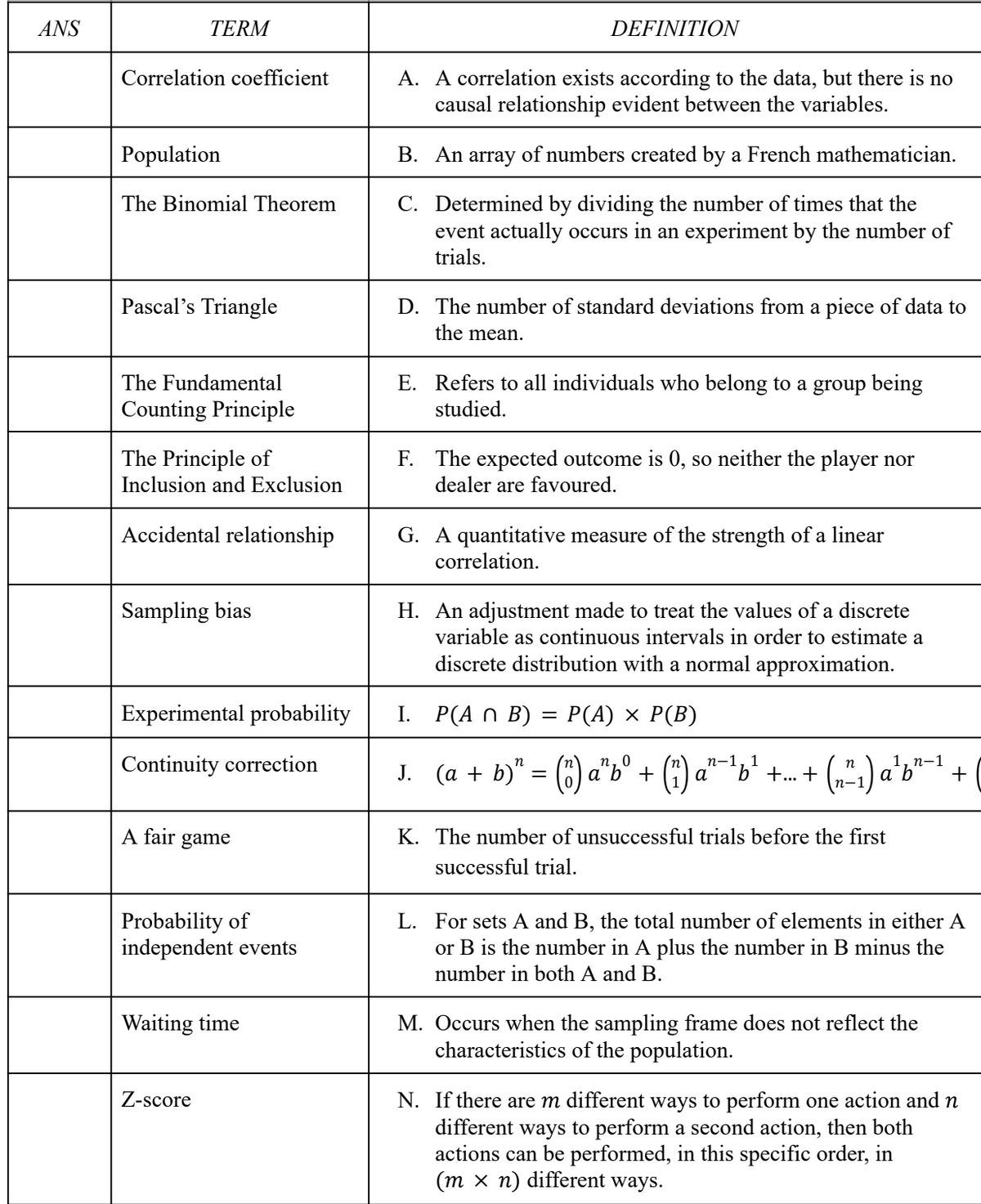ANS TERM Correlation coefficient Population The Binomial Theorem Pascal's Triangle The Fundamental Counting Principle The Principle of Inclusion and Exclusion Accidental relationship Sampling bias Experiment probabilit Continuity correction A fair game Probability of independent events DEFINITION A. A correlation exists according to the data, but there is no causal relationship evident between the variables. B. An array of numbers created by a French mathematician. C. Determined by dividing the number of times that the event actually occurs in an experiment by the number of trials. D. The number of standard deviations from a piece of data to the mean. E. Refers to all individuals who belong to a group being studied. F. The expected outcome is 0, so neither the player nor dealer are favoured. G. A quantitative measure of the strength of a linear correlation. H. An adjustment made to treat the values of a discrete variable as continuous intervals in order to estimate a discrete distribution with a normal approximation. I. P(An B) = P(A) × P(B) n-1,1 n 1, n-1 J. (a + b)² = (") a¹b⁰ + (1) a¹¯¹b²¹ +...+ (₂²₁) a²b²¯¹ + K. The number of unsuccessful trials before the first successful trial. L. For sets A and B, the total number of elements in either A or B is the number in A plus the number in B minus the number in both A and R
ANS TERM Correlation coefficient Population The Binomial Theorem Pascal's Triangle The Fundamental Counting Principle The Principle of Inclusion and Exclusion Accidental relationship Sampling bias Experiment probabilit Continuity correction A fair game Probability of independent events DEFINITION A. A correlation exists according to the data, but there is no causal relationship evident between the variables. B. An array of numbers created by a French mathematician. C. Determined by dividing the number of times that the event actually occurs in an experiment by the number of trials. D. The number of standard deviations from a piece of data to the mean. E. Refers to all individuals who belong to a group being studied. F. The expected outcome is 0, so neither the player nor dealer are favoured. G. A quantitative measure of the strength of a linear correlation. H. An adjustment made to treat the values of a discrete variable as continuous intervals in order to estimate a discrete distribution with a normal approximation. I. P(An B) = P(A) × P(B) n-1,1 n 1, n-1 J. (a + b)² = (") a¹b⁰ + (1) a¹¯¹b²¹ +...+ (₂²₁) a²b²¯¹ + K. The number of unsuccessful trials before the first successful trial. L. For sets A and B, the total number of elements in either A or B is the number in A plus the number in B minus the number in both A and R
Glencoe Algebra 1, Student Edition, 9780079039897, 0079039898, 2018
18th Edition
ISBN:9780079039897
Author:Carter
Publisher:Carter
Chapter10: Statistics
Section10.5: Comparing Sets Of Data
Problem 29PFA
Related questions
Question
100%
Pls help ASAP. Pls do all of them and clearly letter them PLS I BEG

Transcribed Image Text:ANS
TERM
Correlation coefficient
Population
The Binomial Theorem
Pascal's Triangle
The Fundamental
Counting Principle
The Principle of
Inclusion and Exclusion
Accidental relationship
Sampling bias
Experimental probability
Continuity correction
A fair game
Probability of
independent events
Waiting time
Z-score
DEFINITION
A. A correlation exists according to the data, but there is no
causal relationship evident between the variables.
B. An array of numbers created by a French mathematician.
C. Determined by dividing the number of times that the
event actually occurs in an experiment by the number of
trials.
D. The number of standard deviations from a piece of data to
the mean.
E. Refers to all individuals who belong to a group being
studied.
F. The expected outcome is 0, so neither the player nor
dealer are favoured.
G. A quantitative measure of the strength of a linear
correlation.
H. An adjustment made to treat the values of a discrete
variable as continuous intervals in order to estimate a
discrete distribution with a normal approximation.
I. P(An B) =
=
P(A) × P(B)
n-1 1
1, n-1
J. (a + b)² = (") a²b⁰ + (1¹) a²¯¹b²¹
α b +...+ (₂²1) a²¹b"-
ασ
K. The number of unsuccessful trials before the first
successful trial.
L. For sets A and B, the total number of elements in either A
or B is the number in A plus the number in B minus the
number in both A and B.
M. Occurs when the sampling frame does not reflect the
characteristics of the population.
N. If there are m different ways to perform one action and n
different ways to perform a second action, then both
actions can be performed, in this specific order, in
(m xn) different ways.
+
Expert Solution
This question has been solved!
Explore an expertly crafted, step-by-step solution for a thorough understanding of key concepts.
Step by step
Solved in 2 steps with 1 images

Recommended textbooks for you

Glencoe Algebra 1, Student Edition, 9780079039897…
Algebra
ISBN:
9780079039897
Author:
Carter
Publisher:
McGraw Hill

Glencoe Algebra 1, Student Edition, 9780079039897…
Algebra
ISBN:
9780079039897
Author:
Carter
Publisher:
McGraw Hill